
A Ukulele Teacher’s experiences and suggestions on buying, tuning and caring for school ukuleles.
School-Bought or Student-Bought Ukuleles?
If you want to teach your class music through the ukulele (which is what this site is dedicated to) you’ll want a school set of ukuleles. Ukuleles are not expensive, but getting thirty students to each spend around $50 on a new instrument is not an option in many schools. So sweet talk, or twist arms, or lobby as you see fit, to convince your school to invest in some ukuleles.
The cost for a class set of soprano ukuleles is going to be somewhere from $1500 to $2000. This may look like a big hit on your CAPA budget, but it’s a one-off; with simple care your instruments will last for years. There are links below to get you started with potential suppliers.
Ideas On What To Buy
You’ve got the budget approval? Get some ukuleles. What will you buy? Here are my preferred options.
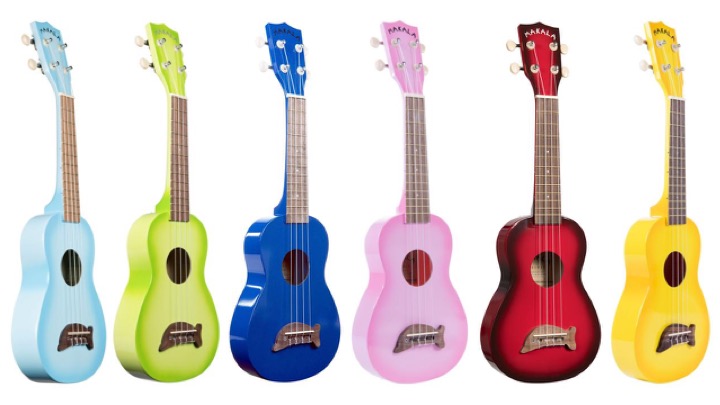
I’ve been using the soprano sized Makala Dolphins with classes for over five years. In that time I’ve had one broken nut (that I fixed) and some chips and scratches – that’s out of sixty ukuleles! The Dolphin is a comfortable, well made, durable instrument with surprising volume, good intonation and pleasing action straight out of the box. These ukuleles have a plastic body, wooden neck and plywood soundboard.
Usually listed at the same price are the Makala Sharks – which are basically the same ukulele as the Dolphin with a satin paint finish, a different range of colours and a different style of bridge. Sharks are also available in the slightly larger “concert” size, which could be more suitable for both the teacher and for High School students.
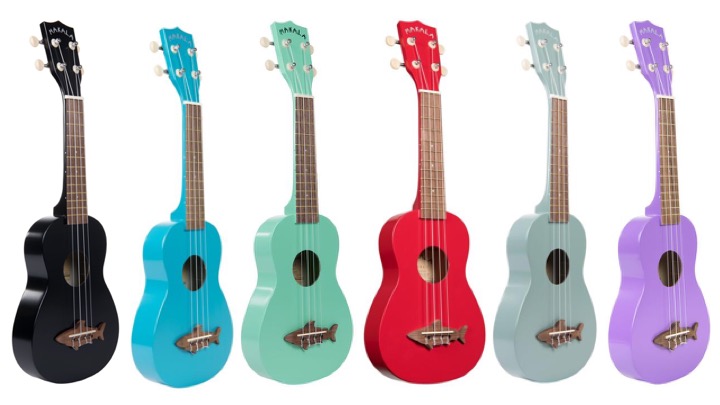
What about the dots? For a little extra, Makala Dolphins can be bought with permanent dot markings for C, F and G7 chords. I prefer to start with a G chord before teaching the G7, as it opens up more keys for playing. Because of this, I suggest avoiding the permanent dots. Chord dots are great to help a class get started but some coloured stickers from a stationer are a better option, and can be removed as students develop their skills.
A little cheaper, a little lighter, and not time tested by me, are the Mahalo Rainbow soprano ukuleles. Many students have bought these as their own first instruments and some suppliers provide them as school sets. I find the sound to be a bit “thinner” than the Makala models and the plywood body feels less sturdy. The action and intonation are both very suitable for beginner students and the price might make them a better choice for some schools.
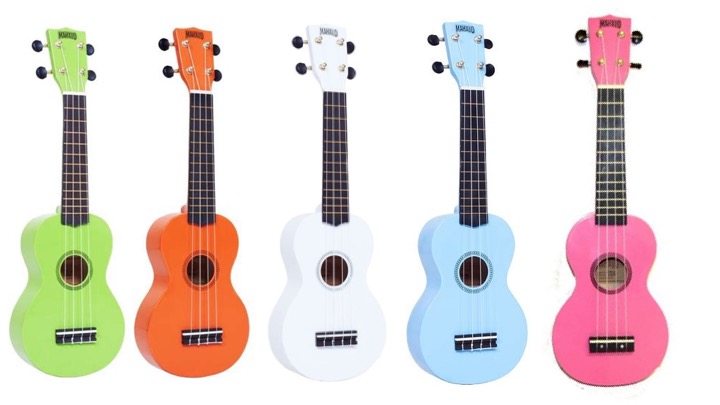
Mahalo beginner ukuleles include some designs that are sure to grab your students’ attention – but may not suit your class set!
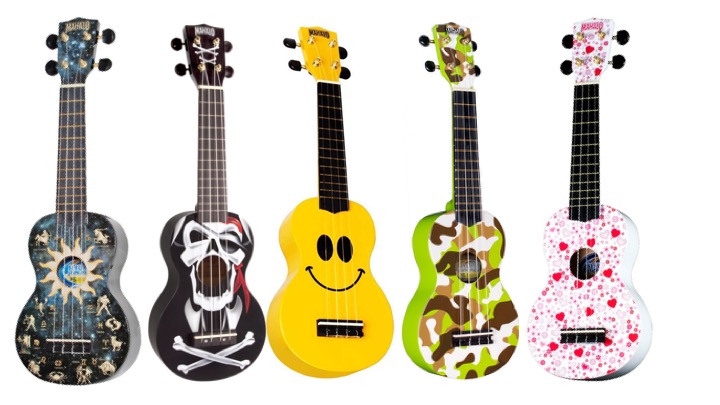
Some suppliers (and the Kala ukulele company) promote the all-plastic Kala Waterman as a beginners ukulele. From numerous on-line comments and my own Waterman experience, I think these are not the best ukulele for school programs – not unless you’re a swim school! The action (string height) is high, making playing less comfortable and sometimes causing problems with the intonation. The Waterman is great for kayaking but not a great first ukulele.
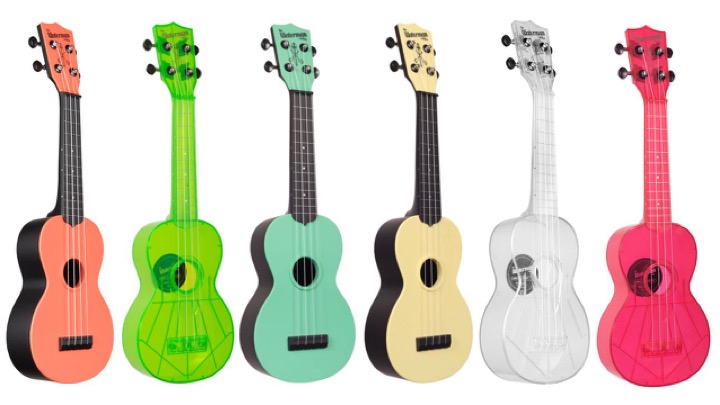
Suppliers. You may find that a local music shop is willing to do a deal for your school, and it can be in their interests to do so. If your students enjoy ukulele at school they are very likely to want to buy their own instruments, and local music shops will benefit from this. You might even be able to arrange discounts for your students with local stores – it’s worth asking.
The School Locker are a supplier with a range of ukuleles including Makala Dolphins. Prices listed are for individual instruments. It would be worth asking about a price for a class set.
External link: https://theschoollocker.com.au/catalogsearch/result/index/?brand=75&q=ukulele
Optimum Percussion sell a lot of percussion instruments – obviously – but they also can supply your school with ukuleles. In 2019 they advertised Makala and Mahalo class sets.
External link: https://www.optimumpercussion.com.au/index.php/makala-class-set-30-ukuleles.html
External link: https://www.optimumpercussion.com.au/index.php/mahalo-class-set-30-ukuleles.html
Tuning, Care and Maintenance
Tips and Tools
When you have thirty ukuleles to tune, it helps to set some time aside. The first tune-up will be the longest as the strings stretch and settle in. Set aside an hour before or after school and be ready for repeated tuning and strumming. If you’re working with more than one class, arrange time between the lessons at first for a full retune. Don’t worry – the more you tune them, the better they will hold their tune, and soon the strings will “settle in”. This on-line tuner provides a great tool for tuning by ear. External link: https://ukutuner.com
Tuning by ear takes a quiet setting, and we all know that quiet can be hard to find. A clip-on tuner with a “chromatic” setting will help you tune in noisy places. These tuners work through the vibration of the ukulele body and neck, not the sound in the air. I use both ROM and Snark clip-on tuners. These are most useful when the strings are close to being in tune.
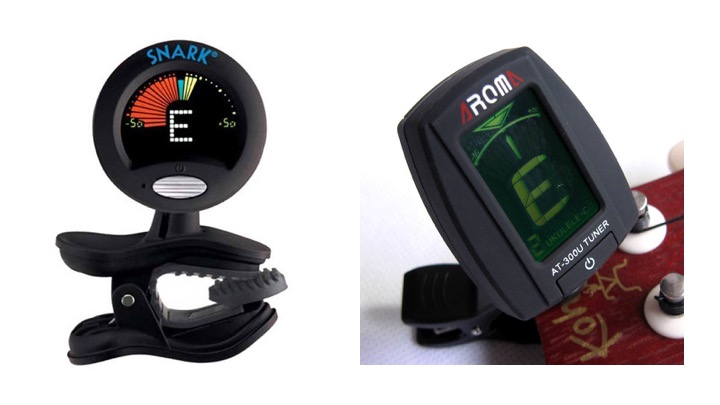
Now the ukuleles I am using have “settled in” I find it quickest to tune them all by ear, using a looped audio track. I run the clip a few times until I have all thirty instruments ready for use. Here’s the Quick Time movie I created and use:
You can get your students to check their own tuning while you distribute or collect ukuleles. This helps them to develop their ear and also controls the noise in the learning space by providing directed activity rather than expecting silence.
Caring For Your Ukuleles

Makala Dolphins and Sharks come in a cardboard box with a lightweight carry bag. These boxes are great for stacking but not so practical for regular use. Over time, if used for storage, the boxes will need to be taped and repaired. Still, if space is tight, this could be your best option.

If you have shelves available, stacking ukuleles in a storeroom is a great option. You could stack them in their bags or just lay them on top of the bags on the shelf. I find having them out of the bags is much more convenient for regular use.

If you have a willing and capable General Assistant – or perhaps someone into wood working – you could go for the dream option – a custom-build ukulele storage facility, like this one at a local high school.

This trolley has proven helpful when setting up for school assemblies. It has been lined with firm felt – a pin-board material – to prevent scratching.

Recently I had a go at building a trolley of my own. This model neatly holds thirty two ukuleles. It’s an adaptation of a design from https://payhip.com/b/mhkO
Changing Strings
With reasonable care, the only maintenance needed for ukuleles is tuning, occasional cleaning (which can be done by wiping with a damp cloth) and string changing (if they break or have become quite old). Soprano ukulele strings do not tarnish or wear as quickly as guitar strings and you may find you can get several years of classroom use from them. Eventually, however, the time for changing strings will come.
There are many videos on-line giving advice on how to change strings. My preference is to make sure that the ends of tied strings point down, away from the student. This is because several students have found that the strings ends, when pointing up, sometimes annoy their hands. I plan to do a video to show string changing. Until then, here’s a useful external link: https://www.youtube.com/watch?v=Wi6EIJB0oSw
Created by Russell Baker, 2019. This work is licensed under a Creative Commons Attribution-ShareAlike 4.0 International License.